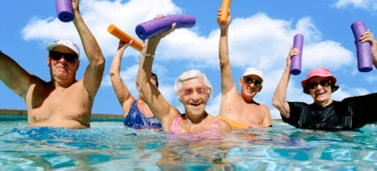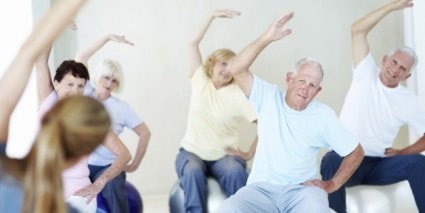Annette Shanahan, Clinical Director, Healthcare Direct
As you age, muscles become less flexible, losing their elasticity and this results in less mobility in the joints. We notice this first in ‘new’ stiffness, as when rising from sitting, stiffness in our feet and toes when we put our feet to the floor in the morning, shoulder soreness on reaching up to high shelves, or to change a light bulb. We start to ask others for help doing tasks we always did ourselves…it’s tough to adjust!
WE CAN MAKE A DIFFERENCE to this, we don’t have to live with all these restrictions. If the joints are not moved through full range regularly, they cease, and deposits build up in the joints leading to arthritis. Normal daily tasks that used to be easy to do, are now more difficult.
Everyone can learn to stretch, regardless of age or present level of flexibility, as tissue is replacing itself all the time, we can re-condition the new fibres in our muscles, and increase joint mobility by exercising or ‘polishing’ the joints with exercise, de-silting the inside of the joints so they move more easily and readily!
“Be kind to your muscles and they will be kind to you!”

Stretching should be a part of your daily routine, whether you exercise regularly or not. Your Chartered Physiotherapist can work with you to develop a stretching programme that works for you.
1. Increased Range of Movement: If you perform regular stretches, the length of the muscles and the tendons are gently increased. This helps to increase the range and the ease of your body’s movements. Limbs become more flexible and joints can move more freely if they are more pliable. This helps to PREVENT INJURY often caused when muscles and tendons at joints are unable to extend to absorb the demands made.
2. Increased Ability to Perform Skills: When you have a full extent of joint movement, in all joints, this enables higher functioning. It helps you to keep doing what you want to do, walking briskly, climbing hills, or just stairs, playing with grandchildren on the floor, riding your bicycle, all these and more activities are possible if you keep active. This helps you to remain independent. Stretching exercise, (including Yoga, Tai chi) will help prevent falls, often the significant event which prompts the decline into old age for many of us. Regular stretching will help you to learn new skills, keeping you conditioned and enhancing your coordination and balance, safeguarding you against falls, fractures and trips to hospital.
3. Injury Prevention: Stretching exercise helps to prevent injury to joints, tendons and muscles. Flexibility has to be maintained by ensuring the muscles are extended fully, ensuring they stay elastic. Joints need to be moved through full range to ensure they remain fit for purpose. Muscle inflexibility leads to joint stiffness and vice versa. Keeping your muscles elastic and your joints mobile and flexible, ensures you will age well! This enables you to stay active, working the muscles fully and maintaining STRENGTH. This strength level is necessary for you to remain able for strenuous work, in the garden, around the house, and during your hobbies and activities.
“Stretching helps you to keep going, and to keep up with the young ones!”
4. Reduce Muscle Tension: Muscles become tense and in spasm, when we maintain postures for too long, as when sitting for hours, travelling in a car, watching TV, or sitting at a computer. Muscles need regular exercise, to pump the blood through the fibres, bringing Oxygen fuel to the tissues. Static postures make us tired and sore. It is important to get up from sitting often, at least every 45 minutes, to walk around for a few minutes to pump the muscles. Muscle tension often builds in the neck, shoulders and back muscles and this can be painful, further limiting our exercise ability.
Good posture is important, so walk tall, walk straight with your head up! The best way to ease muscle tension and ache, is to exercise. A brisk walk building your time gradually is often the best way to ease out tense muscles. Stretch before and afterwards, to maximize the level of flexibility. Stretching will help to reduce muscle soreness.
5. Enhance Energy: If you can maintain strength and joint mobility, you will be able to move for longer periods, which will increase your aerobic fitness. The more you exercise, the more efficient your fuel transport system will be. You can keep going for longer and be less fatigued if you keep exercising regularly. Having the ability to move more often and more easily will also give you more energy. Stretching will also help enhance your body’s awareness. If you stretch regularly you can reduce the energy demands on your body, which increase when we are stiff sore and weak. If you address your fitness with regular exercise and stretching, you will improve your overall energy level.
So you have more energy to do more and to really live your life!
6. Reduces Cholesterol: Recent research has indicated that performing prolonged stretching exercises, like yoga, on a daily basis can help you to reduce cholesterol. You must also ensure you adhere to a healthy diet plan. There are so many benefits to incorporating a stretching programme into your everyday lifestyle. It doesn’t take very long. You can incorporate stretching in your everyday activities easily, stretch your calf muscles while waiting for the kettle to boil, stretch when you stand up from sitting extending arms upwards, or stretch in the bathroom after washing your hands, ensuring your wrists, elbows and shoulders are stretched and eased regularly .
If you experience any pain or discomfort while completing your physical activities, please contact your GP or local Chartered Physiotherapist for further assessment and advice on a specific plan for you, to help you to age well.

You can get in touch with us on email: info@healthcaredirect.ie or telephone: 1850 749746.

